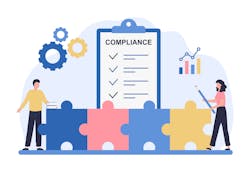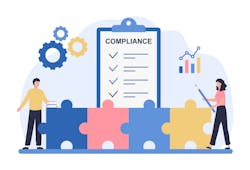The six essential soft skills of a successful compliance leader
There’s no denying that a successful compliance leader has to have technical skills in spades. But whether they lead a small team or dozens of people, their soft skills are equally as important today.
In the worst-case scenario, leadership sees the compliance leader as merely the person who tries to avoid bad outcomes that often result from the failure to adequately check some boxes. Ouch. But a compliance leader's role is not strictly about prevention of certain risks, but rather, about getting ahead of the curve and improving overall processes – and with the right soft skills, these leaders can directly enable the company to seize opportunities and grow.
Here are the six soft skills which are essential to being a successful compliance leader. Cultivating these abilities and adhering to them in day-to-day operations is crucial to being a valued leader with company-wide support, who is seen by other departments and leadership as the helm of a vital, business-enabling function.First skill: The ability to communicate at all levels
Getting the job done requires the support and cooperation of everyone in the company. Each employee can do their part to keep compliance processes working, or they can choose to ignore controls whose purpose isn’t clear to them. Their choice determines whether a compliance leader looks good in the eyes of their superiors.
With this, a successful leader aims to reduce the frustration of other departments by showing how compliance is relevant to their roles and why their efforts matter, taking their needs and pressures into account. In addition, they clearly demonstrate the need for senior leadership support by quantifying risk so they can determine what measures they will fund in order to keep overall risk at an acceptable level for a solid compliance posture.
Second skill: A burning need to sweat the small stuff
Yes, compliance leaders need to see the big picture: they have the whole business’s compliance structure in their hands. Mastering the big picture, however, only happens when they know every detail. Like Georges Seurat’s tiny dots that metamorphose into the magnificent A Sunday on La Grande Jatte, every detail of every department’s compliance effort, or failures, goes into creating the masterpiece that is a flexible, complete Compliance structure. Seemingly small compliance errors—like granting temporary authorization and then forgetting to revoke it—can lead to costly gaps. And while the actual execution requires technical aptitude, the instinct to even get there takes the softer skill to be detail oriented.
So, the successful leader really sweats the details. For example:
● They understand every department’s tools, processes, and people
● They ensure departmental compliance controls that reflect the company’s risk tolerance
● They know the requirements of every framework adopted by the company
● They cross-map frameworks where possible, for more rigorous, easier-to-manage compliance
A side benefit: as conditions change, the leader more readily understands how compliance efforts will be affected.
Third skill: A desire to always be learning
The successful compliance leader anticipates change and keeps up with everything from evolving regulations and industry changes to security updates and threats, compliance updates, and anything else that could potentially affect the company’s compliance ecosystem.
A daunting list? Maybe. But making time to keep current is the only way a company’s compliance will always reflect current standards, no matter their evolution.
Fourth skill: Knowing when to make bold moves—and when not to
Voltaire’s saying, “Perfect is the enemy of good,” applies to compliance. While in an ideal world, compliance would remain “perfect” at all times, a masterful leader can effectively use their judgment to consider the money, time, and risk tolerance to achieve “good enough.” So, when choosing between different controls to implement, or meeting fast-changing industry requirements, the successful leader knows when to wait for more information or for a situation to develop further, and when it’s time for action, even with imperfect information and without depleting unnecessary time and resources to get there.
Fifth skill: Cross-organizational intelligence and understanding
A compliance leader needs a very wide and very deep area of knowledge. They need to speak the languages of many different departments, including IT, engineering, R&D, marketing, and product development. Subject matter experts and compliance leaders get frustrated when they can’t adequately translate their own point of view into the other person’s language.
The successful leader starts by getting the details right. (See above on “sweating the small stuff.”) To explain to a department head why the company’s compliance requirements mandate a certain control, for example, the leader will understand the department well enough to know how the control can both function within a department’s existing structure and also yield information that the department considers relevant.
Learning to speak the same language as different stakeholders helps make compliance relevant to what they prioritize and results in better controls and better cooperation across an entire organization.
Sixth skill: A talent for inspiration
A successful leader inspires at all levels. They motivate stakeholders throughout the company so that they will want to follow recommendations and implement controls. And the leader gives them credit when the company achieves a new milestone because they helped make it happen. And they inspire company leadership to view compliance as a business driver. When leadership recognizes compliance as enabling the company to embrace further opportunity and growth while reducing overall business risk, compliance will be respected as part of the business fabric of the company, not just an add-on.
Soft skills as a Compliance leader: the essential difference
When it comes to leading compliance, the leader has two options: They can either check the box and get the job done or they can develop the skills of a great compliance leader and let compliance be a business driver.
Above all, successful compliance leaders:
● See the big picture but focus on getting the essential details right
● Understand the workings of all departments, helping everyone see a common goal
● Know when to act and when to hold back
● Learn continuously, so they keep on top of change
● Effectively communicate with stakeholders at all levels
● Motivate and inspire throughout the company
With this unique blend of skills, other departments will clearly understand how compliance controls are relevant to what they do, and it will help them feel like a respected part of the compliance effort. And company leadership will support the compliance leader because they see compliance as delivering operational value to the business. The successful leader has the capabilities that make their job easier, while continually improving their performance, to transform compliance from a hurdle into an essential part of the company’s business and solidifies them as a pillar to the organization and function that helps enable business growth.
About the Author

Yair Kuznitsov
co-founder and CEO, anecdotes
Yair Kuzitsnov is CEO and co-founder of anecdotes, the first Compliance OS and he’s on a mission — to remove the frustration that typically accompanies Compliance and, in the process, save InfoSec teams millions of hours per year collectively. After building and managing teams in different units across the IDF Intelligence Corps, Yair became the head of the hardcore R&D section of the IDF’s elite 8200 unit. After leaving the army, he led the Innovation Group at Intsight, where he successfully brought new products into a highly competitive market. In 2020, he started anecdotes with Roi and Eitan to re-build the InfoSec Compliance ecosystem to fit the Cloud era. Yair is an avid skier, piano player, and builder.


